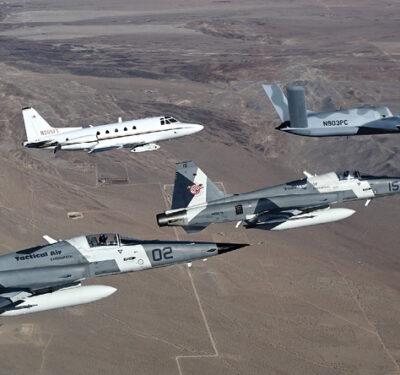 Cyber warfare gets a lot of press these days—if it isn’t the Chinese stealing millions of U.S. Federal personnel records, it’s the Russians breaking into the Democratic National Headquarters email, the North Koreans hacking Sony or unnamed hackers cracking Uber’s servers. You can’t open a website or change the channel without hearing about more cyber horrors, but are we really picking up on the whole cyber warfare game? Is there more to it than hackers in dark rooms stealing passwords and cracking into Wall Street servers? I think there is. I think our major adversaries are playing the long game and have a plan to not only dominate the digital world, but to use our own technology—and freedoms—against us. And it’s about to get worse as the world switches from human controlled operations to autonomy. Drones will see the first wave of what I call autonomy warfare.
Cyber warfare gets a lot of press these days—if it isn’t the Chinese stealing millions of U.S. Federal personnel records, it’s the Russians breaking into the Democratic National Headquarters email, the North Koreans hacking Sony or unnamed hackers cracking Uber’s servers. You can’t open a website or change the channel without hearing about more cyber horrors, but are we really picking up on the whole cyber warfare game? Is there more to it than hackers in dark rooms stealing passwords and cracking into Wall Street servers? I think there is. I think our major adversaries are playing the long game and have a plan to not only dominate the digital world, but to use our own technology—and freedoms—against us. And it’s about to get worse as the world switches from human controlled operations to autonomy. Drones will see the first wave of what I call autonomy warfare.
The Superpowers
This new type of warfare is producing new types of superpowers. Just having nuclear weapons doesn’t get you into the new superpower club. Cyber capacity is the deciding factor. Countries with the best (and most) coders, the most extensive cyber production capability, the best cyber infrastructure and best regulatory environment are the new superpowers. Using these measures, the United States and People’s Republic of China are the sole cyber superpowers. True, the Commonwealth nations (particularly the UK and India), Western Europeans, Israelis and Russians are formidable cyber powers, but all lack the massive numbers of coders, computer engineers, available capital and, most importantly, cyber industrial capacity to be true cyber superpowers.
The United States remains the top superpower—for now. We became a cyber superpower much like we dominated the world back when military power and industrial capacity determined superpower status—by using American innovation to drive a free market economy largely free of government regulation. The fiercely competitive American market, not its government, drove nearly all the growth in America’s cyber power. True, the American military and intelligence community did make major breakthroughs—DARPA invented internet protocol messaging; up until the mid 1990s the world’s faster supercomputer title was a race between the U.S. National Security Agency and the UK’s Government Communications Headquarters (the two also contest who invented the computer). However, the free market left the government in the dust starting in the early 1980s. Mainframes were too bulky for American business, so Intel invented the microprocessor, Microsoft invented the operating system and IBM invented the personal computer. The internet may have worked for DARPA, but normal people could never access it until Mosaic improved on Sir Tim Berners-Lee’s “world wide web browser” and Cisco manufactured MIT’s “internet router” in massive numbers. Internet signals flashed over fiber optics invented by Corning Glass (based on British research). When cables became an encumbrance, internet traffic switched to Motorola’s “cellular phone” and then to “WiFi” built by AT&T (based on Australian research—I’m seeing a pattern here…).
What America didn’t do as they invented modern computing was to consider security from the start when developing these systems. To this day, Silicon Valley has successfully resisted most regulation, however sensible. As a result, we have an Internet that is impossible to secure and social media apps like Facebook that Russian intelligence can easily manipulate to spread propaganda.
How China Became a Superpower
American cyber achievements are impressive, but China started to catch up when cheap Chinese labor attracted the bulk of America’s cyber production capacity. China took a radically different approach from America in becoming a cyber superpower. Whereas the U.S. let the market guide cyber development, China used government guidance supported by their intelligence community to leapfrog ahead by outright stealing code, convincing American companies to manufacturer in China, strategically acquiring American cyber companies and using America’s own massive university system to train their computer scientists and engineers. Unlike America’s market based system, most moves made by China are government directed and supported by the full power of the state. China has done an impressive job of catching up with America in a short time.
China actively uses America’s free market system against the United States. Few American students could attend Chinese universities for cyber education (assuming they’d want to). According to the Pew Research Center, 57 percent of doctoral degrees in engineering and 53 percent of doctoral degrees in computer and information sciences went to foreigners in 2012-13. More than half of these foreign students were Chinese. Few countries on earth would have permitted the bulk of their chip and memory manufacturing to move to a foreign country (let alone an adversary country) because production costs were lower, but America did. Intel Corp is the last remaining company that has major chip manufacturing in America. The United States could never direct an American company to buy a foreign company to acquire technology to advance the American cyber industrial base, but China does it routinely. Remember that IBM personal computer invention I mentioned earlier? The Chinese company Lenovo now owns it.
The Road to the Cyber Wars
We’re about to see a replay of the early 21st Century cyber wars as the world switches to autonomous systems and drones will be the first battlefield. Again, this is a technology pioneered by the United States (and its close ally, Israel). Israel developed the first modern drone, the Scout, in the late 1970s and used it to massacre the Syrian Air Force over the Bekka Valley in 1983. A dual Israeli/American citizen developed the first beyond line of sight drone, the MQ-1, in the late 1990s and the U.S. Air Force used it to gut Al Qaida after 9/11. Northrup Grumman made the first nearly autonomous drone, the RQ-4 Global Hawk, in the early 2000s.
What America did NOT do is dominate the consumer and commercial drone market, largely because of their failure to provide sensible civil drone regulations. That hasn’t stopped China from dominating the limited markets where American regulations allow drones to fly. China’s DJI commands between 70 and 90% of the consumer/prosumer market in the U.S. China’s Yuneec is a distant second followed by France’s Parrot (all of which are manufactured in China). China is equally active in shaping the development of American drone regulations and standards. DJI is the co-chair of the FAA’s Drone Advisory Council and has been invited to every FAA drone aviation rulemaking committee convened so far. DJI is a reliable and active member of every major ASTM and RTCA drone standards committee. DJI also uses its considerable market influence to shape the American unmanned traffic management (UTM) system. American UTM providers know they can’t risk alienating DJI or they risk getting cut off from DJI’s systems.
If you think all this activity is merely economic, I suggest you re-read the paragraphs above on cyber warfare. Penetrating every aspect of America’s first autonomous systems is probably a major goal of the Chinese and a first shot in the autonomy wars.
The Threat to Security
Autonomous systems implemented badly are a major security risk to any country. Unlike manned systems, there are no humans in the loop and autonomous systems can be hacked and repurposed to do relatively passive tasks like espionage or active tasks like purposefully crashing. To use an example before the autonomous age, if the Nazis wanted to steal the RAF’s Spitfire design and manufacture it, they would have to steal hundreds of paper blueprints, spend months retooling factory presses and years manufacturing their ill-gotten analog aircraft. Pilot training would have taken years. Autonomous aircraft designs exist as CAD drawings that can be instantly transferred to manufacturing robots or 3-D printers. Pilot training isn’t an issue. Simply steal flight algorithms while hacking the CAD drawings. A modern adversary can hack their way into a first class autonomous Air Force in months or weeks—not years.
Or adversaries can cause havoc by re-purposing existing autonomous military and commercial drones. Autonomous drones are particularly vulnerable to autonomy warfare. Drones require a data link to function and their ground control stations are often connected to the Internet directly. Most commercial drones will connect with a UTM, introducing another attack vector for autonomy warfare. The Americans are once again minimally regulating drones to allow market forces maximum flexibility to drive innovation. Drones less than 55 lbs don’t require airworthiness standards and standards for larger drones are still in their infancy. America appears poised to repeat their mistakes from the early age of cyber warfare.
There is, however, considerable hope for drone security at the dawn of the autonomy age. There are large numbers of consumer drones in the U.S., but not large numbers of commercial drones—yet. The FAA decided not to impose security requirements on drones less than 55 lbs flown within visual line of sight, but they haven’t decided how to regulate large drones or small drones that fly beyond line of sight. UTM is in its infancy and it’s not too late to add viable security standards. Perhaps most importantly, the FAA hasn’t issued regulatory guidance for UAS remote identification, operations over people, beyond line of sight, large UAS or even autonomous operations themselves. There’s still time to put their foot down and recognize that industry will resist security regulation. There’s still time to recognize that China is playing the long game and will do what they can to shape our regulations to make it easier for them to win at autonomy warfare.
Will the FAA step up and recognize that cyber security is key to aviation safety in the autonomy age? Will they stand up to industry and write sensible security standards into airworthiness standards and regulations? They didn’t hesitate to dictate bird impact standards to airline manufacturers. Will they do the same for a much, much larger threat to aviation safety?






